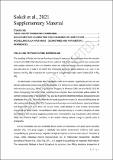Files in this item
Quantifying metasomatic high-field-strength and rare-earth element transport from alkaline magmas
Item metadata
| dc.contributor.author | Sokół, Krzysztof | |
| dc.contributor.author | Finch, Adrian Anthony | |
| dc.contributor.author | Hutchison, William | |
| dc.contributor.author | Cloutier, Jonathan | |
| dc.contributor.author | Borst, Anouk Margaretha | |
| dc.contributor.author | Humphreys, Madeleine C. S. | |
| dc.date.accessioned | 2021-12-08T11:30:16Z | |
| dc.date.available | 2021-12-08T11:30:16Z | |
| dc.date.issued | 2022-03-01 | |
| dc.identifier | 277015229 | |
| dc.identifier | 04516dba-a96d-4cf0-b094-ba46f74df23f | |
| dc.identifier | 85125527072 | |
| dc.identifier | 000763314300009 | |
| dc.identifier.citation | Sokół , K , Finch , A A , Hutchison , W , Cloutier , J , Borst , A M & Humphreys , M C S 2022 , ' Quantifying metasomatic high-field-strength and rare-earth element transport from alkaline magmas ' , Geology , vol. 50 , no. 3 , pp. 305-310 . https://doi.org/10.1130/G49471.1 | en |
| dc.identifier.issn | 0091-7613 | |
| dc.identifier.other | ORCID: /0000-0002-3689-1517/work/104618612 | |
| dc.identifier.other | ORCID: /0000-0002-9432-9880/work/104619181 | |
| dc.identifier.other | ORCID: /0000-0003-0775-1491/work/104619205 | |
| dc.identifier.other | ORCID: /0000-0002-9261-6990/work/104619437 | |
| dc.identifier.uri | https://hdl.handle.net/10023/24488 | |
| dc.description | This work was supported by NERC IAPETUS DTP (ref: NE/L002590/1). A.A.F., W.H. and A.M.B. acknowledge support from the SoS RARE (ref: NE/M010856/1) and HiTech AlkCarb consortia of the EU Horizon 2020 R&I programme – grant 689909; W.H. also acknowledges a UKRI Future Leaders Fellowship (ref: MR/S033505/1). | en |
| dc.description.abstract | Alkaline igneous rocks host many global High Field Strength (HFSE) and Rare Earth Element (REE) deposits. While HFSE are commonly assumed to be immobile in hydrothermal systems, transport by late-stage hydrothermal fluids associated with alkaline magmas is reported. However, the magnitude of the flux and the conditions are poorly constrained and essential to understanding the formation of REE-HFSE ores. Here we examine the alteration of country rocks (‘fenitization’) accompanying the emplacement of a syenite magma at Illerfissalik in Greenland, through analysis of changes in rock chemistry, mineralogy and texture. Our novel geochemical maps show a 400 m wide intrusion aureole, within which we observe typically tenfold increases in the concentrations of many elements, including HFSE. Textures suggest both pervasive and structurally-hosted fluid flow, with initial reaction with the protolith’s quartz cement leading to increased permeability and enhancing chemical interaction with a mixed Ca-K-Na fenitizing fluid. We estimate the HFSE masses transferred from the syenite to the fenite by this fluid and find ~43 Mt of REE were mobilised (~12% of the syenite-fenite system TREO budget) – a mass comparable to the tonnages of some of the world’s largest HFSE resources. We argue that fenite can yield crucial information about the tipping points in magma evolution as retention or loss of volatile-bonded alkali and HFSE is key for development of magmatic zirconosilicate-hosted HFSE ores (i.e. Kringlerne, Ilimaussaq), or formation of the syenite-hosted Nb-Ta-REE (Motzfeldt-type) roof-zone deposits. | |
| dc.format.extent | 6 | |
| dc.format.extent | 1919091 | |
| dc.format.extent | 1316089 | |
| dc.language.iso | eng | |
| dc.relation.ispartof | Geology | en |
| dc.subject | Fenite | en |
| dc.subject | Mass-transfer | en |
| dc.subject | Critical elements | en |
| dc.subject | Alkaline magmas | en |
| dc.subject | Rare-earth-elements | en |
| dc.subject | Skarn | en |
| dc.subject | QE Geology | en |
| dc.subject | DAS | en |
| dc.subject | NERC | en |
| dc.subject | MCC | en |
| dc.subject.lcc | QE | en |
| dc.title | Quantifying metasomatic high-field-strength and rare-earth element transport from alkaline magmas | en |
| dc.type | Journal article | en |
| dc.contributor.sponsor | NERC | en |
| dc.contributor.sponsor | European Commission | en |
| dc.contributor.sponsor | Medical Research Council | en |
| dc.contributor.institution | University of St Andrews. School of Earth & Environmental Sciences | en |
| dc.identifier.doi | 10.1130/G49471.1 | |
| dc.description.status | Peer reviewed | en |
| dc.identifier.grantnumber | NE/M010856/1 | en |
| dc.identifier.grantnumber | 689909 | en |
| dc.identifier.grantnumber | MR/S033505/1 | en |
This item appears in the following Collection(s)
Items in the St Andrews Research Repository are protected by copyright, with all rights reserved, unless otherwise indicated.


